Use controls above or click here to open this Hometown Heroes podcast in a new window
Episode #624 of Hometown Heroes, airing April 16-20, 2020, honors the legacy of Dr. Fitzalbert Marius, who passed away April 10th at the age of 98. A talented painter, musician, tailor, sculptor, author, and teacher, Dr. Marius credited World War II with turning his path toward medicine. Starting with Fresno, CA’s very first open heart surgery in 1958, Marius performed more than 11,000 cardiac operations before retiring from surgical duties at age 91. He was fond of saying that when he stepped away from “physiological heart repair,” he focused exclusively on “spiritual heart repair,” and he was active in teaching and ministry until the day of his passing.
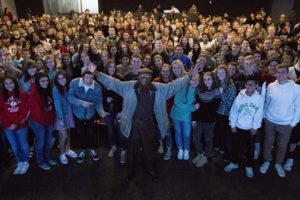
“I just simply have priorities,” Marius often responded when asked about his prolific, accomplishment-filled life. “I don’t waste any time at all.”
Marius, who first shared his story on Hometown Heroes in 2018 (access part I here or part II here), was born in Colon, Panama in 1922, while his father, a native of St. Lucia, was working on the Panama Canal. The family moved to Harlem, NY when Fitzalbert was 3 years old, and he became quickly accustomed to communal life in a “railroad apartment,” with three generations of family dwelling in his sixth-floor unit near 137th St. & 8th Ave.
“You had to learn to live with other people with respect,” he recalled. “It had an influence on the attitude that I developed.”
The second of six children, “Bert,” benefited from a Marius family rule that required children, at age 7, to take up a musical instrument, and to learn a trade. He began playing the violin and became an apprentice tailor, and thus were born two affinities that stuck with him the rest of his life. Painting and poetry were additional pursuits that he acquired in his childhood, fueling young Bert’s dreams.
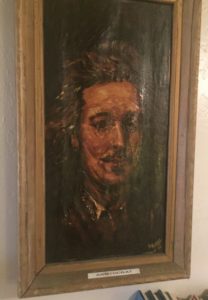
“My main ambition had always been this: to be a Rembrandt or Leonardo da Vinci,” you’ll hear Marius explain. “I never wanted to go into medicine or nothing else, I wanted to be a Rembrandt.”
At Frederick Douglass Junior High School, Bert came under the tutelage of Countee Cullen, a famed Harlem Renaissance poet who taught Marius in both French and English. Cullen’s encouragement to develop his artistic voice resonated with Bert as he moved on and became one of the few African-American students at Stuyvesant High School. Graduating at age 17, he had a scholarship to Brooklyn’s Pratt Institute, but after a month of studying art there, he dropped out and moved to Greenwich Village. Bert and a friend shared an apartment there, earning meals at the Village Vanguard by showcasing their poems during late night “jam sessions” that often featured jazz legends like Count Basie, Jimmie Lunceford, and Ella Fitzgerald.
“I met all those musicians down there,” Marius related on Hometown Heroes. “As they played the jam session, we would write the poetry, and we’d get up and recite it to the music.”
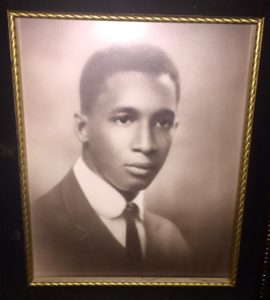
In 1940, he enrolled at Lincoln University in Oxford, CA, majoring in architecture. That’s where he was on December 7th, 1941, when Imperial Japan’s surprise attack on Oahu and other American positions drew the United States into World War II. Near the end of his sophomore year, word began to spread about the Army Specialized Training Program (ASTP), with an accelerated path toward a career in medicine. The normal eight years required to acquire an M.D. could be reduced to four, and the Army would pay for it.
“I moved and became Pre-Med,” he explained of his wartime decision to join ASTP. “And that’s how I got into medicine.”
His path toward a pioneering medical career would take some unexpected twists and turns in the months and years that followed. A screening interview at Fort Dix in New Jersey presented an interview question he wasn’t sure how to answer, but the response he summoned to led to an ultimately life-threatening detour caused by a case of mistaken racial identity.
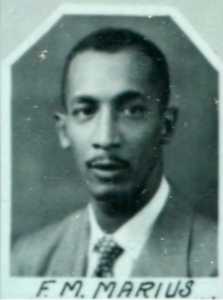
“Back in those times, the Army was absolutely segregated,” Marius said, noting that only four ethnic classifications existed. “White, colored, yellow, and red. You had to fall into one of those four categories.”
Listen to Hometown Heroes for Bert’s inimitable explanation of how that interview unfolded, against the backdrop of a prevailing myth of the era that suggested for a white man to look a black man directly in the eye was bad luck, akin to walking under a ladder or crossing paths with a black cat. The caucasian lieutenant conducting the interview avoided eye contact as he went through a litany of questions, but the file of Fitzalbert Michael Marius appeared a little different from the majority of the nearly one million African-Americans who served in World War II.”None of these characteristics match anything ‘colored,’” you’ll hear Marius relate. “These characteristics that are written down there are the characteristics you find associated with an intelligent white man.” As Marius confirmed every detail of the file, the lieutenant still had not made eye contact.
“He looked up for the first time,” Marius explains. “His eyes opened wide, because what he saw did not match what was on the paper.”
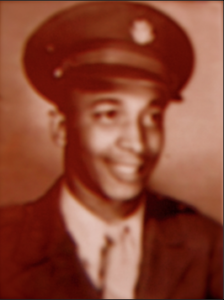
Ultimately, the confused officer asked Marius bluntly if he was “colored.” You’ll hear Dr. Marius speculate that a simple “yes” answer would have landed him in a pre-med ASTP group at one of the six history black colleges and universities that participated. Instead, his response was “What do you think?,” and after pausing to examine the file a little longer, the lieutenant made some final notes on the file, the implications of which Bert would not discover until months later. The next morning, he was put on a train to Denver, where he became the only African-American in a group of nearly 2,000 medical personnel training at Fitzsimmons General Hospital. For the next three months, Marius said, he “slept with one eye open” in his top bunk. The bottom bunk was occupied by a young man from Georgia, whose father, as Marius recalled, was the Grand Wizard of the Ku Klux Klan. You’ll hear Marius remember enduring racially-motivated verbal and physical abuse, which culminated in a very close call, just before the conclusion of their training.
“Six of them caught me off to the side by myself,” Bert related. “Grabbed me by the feet and had me hanging upside-down, dipping my head into a barrel of oil, where they were gonna drown me.”
Just at that moment, a captain walked by and forced Bert’s tormenters to release him, though they were never disciplined. It wasn’t until he arrived at Medical Administrative Officer Candidate School at Camp Barkeley, near Abilene, TX, that the picture began to crystallize. Standing at attention in front of his captain while his records were reviewed, Bert finally realized what had happened. “He just fell out laughing,” you’ll hear Marius say of the captain. “He got a big long stamp, about 8 inches, and then he stamped right across the middle of the document, ‘COLORED.’” That flippant reply of “What do you think?” at Fort Dix had apparently led the lieutenant to classify this black soldier as white, and you’ll hear Bert’s theories as to why that might have been.
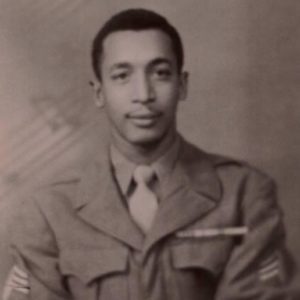
“When the Army was completely segregated, Fitzalbert M. Marius, for almost three months, was white,” you’ll hear him summarize. “But it almost got me killed. It was the worst three months that I’ve ever spent in my whole life.”
That is quite a statement, considering the places he’d go and the challenges he would encounter over the next three years. Now that he was “black again,” as he put it, he was assigned to the 725th Medical Sanitary Company, a segregated unit that followed the 1st Marine Division on several Pacific landings. His French language skills came in handy in New Caledonia, where he was pressed into interpreter duty, but his regular responsibilities came with a heavier burden. Digging ditches, draining swamps, and spraying for insects were easier to bear than collecting the dead from both sides of the battle and burying them. For the invasion of Iwo Jima, straws were drawn to decide whether Bert’s 725th Company, or the parallel 727th Company, would have to go in with the initial landing force. The 727th drew the short straw.
“Only three of them made it back,” you’ll hear him say of that 125-man company. “All the rest of them got killed.”
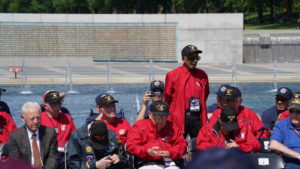
You’ll hear Marius remember other twists of fate and close calls, from hunkering in a foxhole on Guadalcanal as Japanese bombs fell, to the time a sniper’s bullet killed a friend right next to him in Cebu City in the Philippines.
“The whole three years or so I was over there in that South Pacific, I did not get one disease,” Marius marveled. “People got shot all around me and I never got one injury. The Lord was looking out for Bert Marius.”
Many of the men in his unit could not read or write, and Marius received permission to start classes to help them. That caused resentment from a few but gratitude from most. He kept his artistic kills sharp by producing watercolor paintings of some of the jungle scenery, and mailing them to friends and family back home in the states. In the Philippines, he tried to master Tagalog, putting together a hand-written dictionary. He would add Japanese when occupation duty in Japan introduced him to an english-speaking professor who could tutor him. The fact that he served in a segregated unit was a reminder of the discrimination African-Americans still faced on the home front, but Marius never felt any equivocation about his mission overseas.
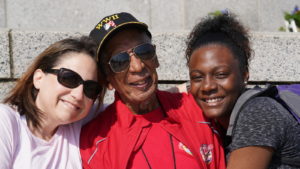
“We weren’t over there to solve prejudice. We were over there to take care of the enemy,” you’ll hear him say. “We understood you could not solve the problems in the United States of America if the Japanese controlled America.
After his return to the U.S. and discharge from the Army in February, 1946, he returned to Lincoln University and graduated in 1948. His anticipated ASTP shortcut to a career in medicine hadn’t materialized, and his previous passions of art and fashion had never left him. He applied and was accepted to École nationale supérieure des beaux-arts in Paris, the most prestigious art school in the world at the time. Bert was on his way to mail a letter to Paris with his intent to attend, when he received an acceptance letter to medical school at Howard University. While drawing the longer straw may have safed his life at Iwo Jima, this time it was the flip of a coin that would alter his destiny, not to mention the lives of thousands of future patients.
Torn between the rare opportunity of medical school and the lifelong dream of turning his artistic talent into a career, he reached into his pocket for a silver half-dollar to flip. It landed on heads, so medicine it was. He tore up his letter to Paris, and headed to Howard.
“I went to medical school on the flip of a coin,” Marius, noting milestone moments he would’ve missed in an alternate reality in which we all paid top dollar for his clothing designs. “I would have been the first black designer in the world.”
Instead he blazed a different trail after graduating from medical school, heading west to intern at Fresno County General Hospital in California. After a general surgery residency there, he worked with heart transplant pioneer Gordon Shumway during animal trials of the procedure at Stanford Lane Hospital in San Francisco.
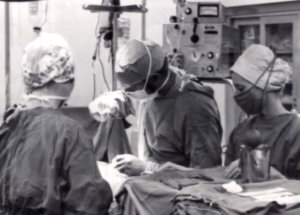
In 1958, Marius teamed with Dr. Byron Evans to perform Fresno’s first open heart surgery, and he spent the next 55 years performing similar procedures. His run-ins with racial discrimination were not over, as he dealt with geographic restrictions in Fresno as to where a black physicians could practice. Kearney Bowl raceway was on the right side of town for him, so he boosted his practice by becoming the track doctor there. He credited his wife, Dorothy, for helping to revolutionize his spiritual life, and he became prolific as a writer of both poetry and ministry manuals. At the time of his passing, Dr. Marius was still actively teaching prospective missionaries at the Fresno School of Mission, as well as facilitating a Sunday school class at Family Community Church.
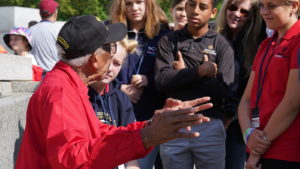
In 2018, Marius joined dozens of his fellow veterans on a journey to Washington, D.C. with Central Valley Honor Flight. Wherever the group stopped, Marius attracted a crowd, always ready to relate some of his unique life experiences in his captivating and enthusiastic style. In 2019, Marius became the first person ever recognized with an honorary doctorate by Fresno Pacific University, adding to his interminable list of awards and accomplishments. Whether speaking in a school setting, to a church group, to his fellow veterans, or even in delivering the invocation for a crowd of 3,000 at the 2020 Fresno/Clovis Prayer Breakfast just weeks before his passing, Marius never allowed people’s effusive praise to settle on his shoulders.
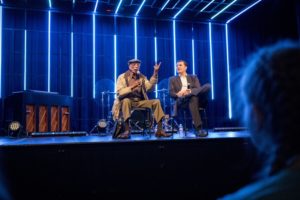
“Anything and everything that Bert Marius is able to accomplish, it is because God gave me the ability to do it,” you’ll hear him say. “I’m not taking any credit for any of this myself. The only credit I’ve taken is the fact that I’m willing to submit to his will, and be his steward and his messenger.”
We can be thankful the man who didn’t waste his time was given 98 years to navigate his one-of-a-kind journey, as vibrant, productive, and passionate when he reached the finish line as any of us could ever hope to be. Rest in peace, Dr. Marius.
—Paul Loeffler

Visit a memorial page for Dr. Marius from his church here, and if you just can’t get enough of Dr. Marius, scroll below for additional content related to his prolific life.

“Needle & Thread” – a short film by Orlando Gomez for Central Valley Community Foundation‘s “The Big Tell” competition:
2018 The Big Tell: Needle & Thread from Central Valley CF on Vimeo.
“Inspiring the Valley” feature from KSEE-24 TV: Juanita Stevenson, reporter & Justin Davis, videographer:
Inspiring the Valley – Dr. Fitzalbert Marius from Justin Davis on Vimeo.
The doctor’s advice to young people – Interview with Addison Schultz of TheFeather.com:
Black History Month keynote address at Family Community Church in February, 2019:
Relating the story of how the Army ended up temporarily classifying him as caucasian:
Delivering a dramatic reading of one of his published poems:
Explaining the symbolism in one of his paintings:
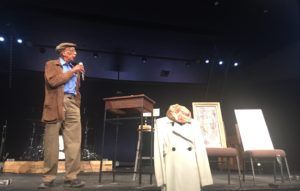
Dr. Marius speaking to men’s breakfast at The Well Community Church in February, 2018
Click here or on the photo at left for link to audio
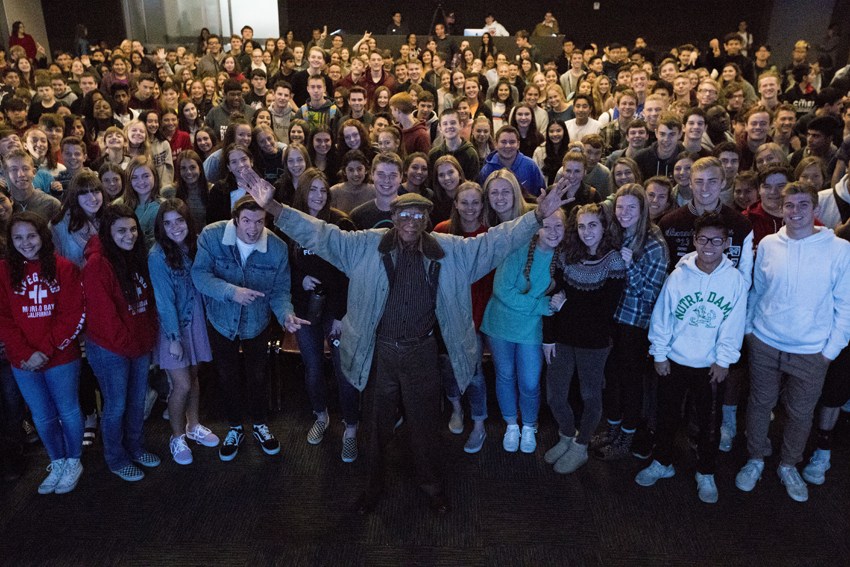
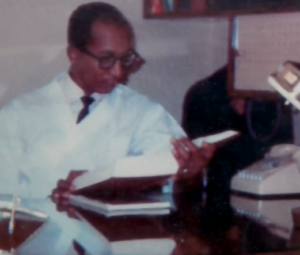
Leave a Reply